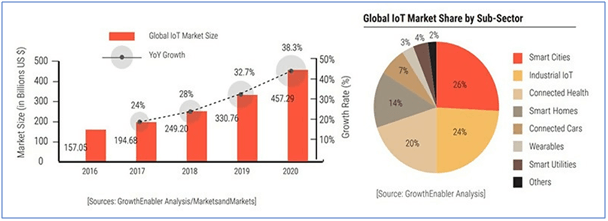Digital technologies will help procurement increase collaboration, analytics, and engagement using a spectrum of tools along the entire procurement value chain, from planning and sourcing to contract negotiations, order delivery, payment, and supplier management. A system of physical things embedded with sensors, software, electronics, and connectivity to allow it to perform better can be defined as The Internet of Things or IoT. By exchanging information with other connected devices, the operator or the manufacturer IoT signifies the importance of IoT Application.
Table of Contents
IoT Applications and The Importance
IoT application can be found in every industry with a diversity of implications for smart homes, travel and transportation, health and personal care, retail, agriculture, construction, etc. For e.g. in the Industrial Segment, the application of IoT revolves around automation and logistics. We will soon see IoT application creating smarter solutions by programmatically adjusting to the human behavior bringing more efficiency and convenience. As a direct result of IoT, businesses are awakening to a new era of the digital enterprise aspiring companies to find new ways of delivering their products and services.
The future battlegrounds for most companies won’t lay within the products they produce or service they offer but instead in the software and automated service layers, those products and services would be wrapped in.
Statistics around IoT
As per the Ericsson Mobility Report, there are currently 4.6 billion connected devices excluding phones, tablets, and laptops which is expected to increase to 15.3 billion in the next 5 years.
A recent study released by Gartner says that 43% of all companies are using or plan to implement an IoT application in 2016. Samsung SmartThings Hub is a successful example IoT solution. Not all smart home devices are single pieces of equipment and there are entire systems that you can use to automate your home. For example, the SmartThings system lets you control lights, locks, plugs, thermostats, cameras, and speakers from a central hub that you can access from your smartphone, as well as a wide range of sensors that you can use with the Smart things system to create a security solution that’s integrated with all of the other electronics in your home.

There are still some barriers to adoption, however, for example, a battery life of devices and cost of devices. GSM and 4G networks are used more, more for IoT application and new advancements recently made in the network software, and device stack will greatly improve on these aspects.
End-to-End IoT System
An end-to-end IoT system contains the following:
• Hardware
These are like sensors or devices. These sensors and devices collect information from the setting (e.g. associate degree air quality sensor) or perform actions within the setting (e.g. raising alarm).
• Connectivity
The hardware wants the way to transmit all that information to the cloud (e.g. causation air quality data) or wants the way to receive commands from the cloud (e.g. raise alarm). for a few IoT systems, there is an associate degree intermediate step between hardware and connecting to the cloud, as an entrance or router.
• Software
This package is hosted within the cloud and is answerable for analyzing the info it’s grouping from the sensors and creating choices.
• User interface:
To create all of the conveniences, there must be the way for users to act with the IoT system; e.g. an online app with a dashboard that shows air quality trends and permits users to require action.
In order to facilitate communication, data flow, device management, and also the practicality of applications, the whole platform is termed an IoT platform. There are over three hundred IoT platforms as of last year and this variety continues to grow. The IoT platform market is growing at a compound annual rate of growth (CAGR) of thirty-third and is anticipated to achieve a $1.6 billion market size in 2021.

An Infrastructure of IoT Platform
1. Connectivity & normalization: to make sure correct information streaming and interaction with all devices it brings completely different/completely different} protocols and different information formats into one “software” interface.
2. Device management: It ensures the connected “things” area unit operating properly, seamlessly running patches and updates for package and applications running on the device or edge gateways.
The full content is only visible to SIPMM members
Already a member? Please Login to continue reading.
References
Aravind Sekar. (2018). “5 Best Examples of IoT Applications In The Real World” https://analyticstraining.com/5-best-examples-iot-applications-real-world, accessed 15/03/2019.
Ginna Koo, GDSCM. (2017). “Digital Procurement for Effective Supply Chain Management”. Retrieved from https://sipmm.edu.sg/digital-procurement-for-effective-supply-chain-management, accessed 15/03/2019.
Gordon Murray. (2017). “Procurement needs a digital strategy”. Retrieved from https://www.slideshare.net/mobile/DrGordonMurray/digital-procurement-strategy05131, accessed 15/03/2019.
Mxmendix. (2019). “Examples of IoT Applications”. Retrieved from https://www.mendix.com/examples-of-iot-applications, accessed 15/03/2019.
Tim Owen S. Yoro, ADPSM. (2018). “How Digital Procurement Transforms the Way Companies Purchase Energy”. Retrieved from SIPMM: https://sipmm.edu.sg/how-digital-procurement-transforms-way-companies-purchase-energy, accessed 15/03/2019.

